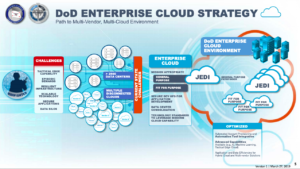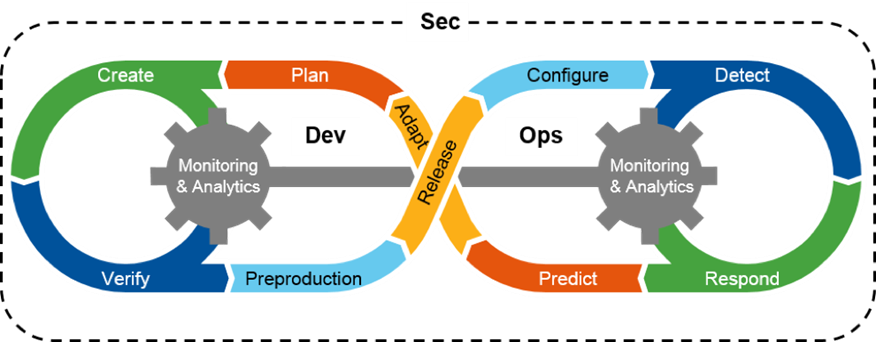
Dana Deasy
WASHINGTON: After months of delays from a still-unfinished court battle, the long-awaited JEDI cloud contract will be neither irrelevant nor overtaken by events when it finally arrives, the Pentagon CIO said this morning. In fact, Dana Deasy told the Defense Writers’ Group, while JEDI itself is in legal limbo, the Defense Department is doing all it legally can to lay the groundwork for a swift adoption as soon as the judge permits.
The big thing the long-awaited Joint Enterprise Defense Infrastructure can do that alternative clouds can’t, he said: provide rapid access to data, across multiple levels of classification, not just to centralized command posts but out to frontline troops on the tactical edge.

The Pentagon’s plan to consolidate many — but not all — of its 500-plus cloud contracts into a single Joint Enterprise Defense Infrastructure (JEDI).
JEDI, Ligado & Legal Limbo
JEDI’s not the only big issue in suspended animation. Deasy and his staff are also trying to convince the Federal Communications Commission to overturn its decision on Ligado, a 5G firm the FCC recently awarded spectrum now used by GPS and other military systems.
“You haven’t heard a lot about it, because we haven’t heard a lot about it,” Deasy told the press. After formally asking the FCC to stay its decision and reconsider it, he said, “we provided all the necessary documentation back to the FCC, all the engineering data. We met individually with each commissioner of the FCC and walked through on any questions they had. And we have simply not heard anything back from the FCC.”
With JEDI, likewise, the timeline is out of the Pentagon’s hands. “The court process is one we don’t control, so I’m not going to tell you, right now, when I think that’s going to come to an end,” Deasy said. “Do I think we’ve done all the right things now? Have we submitted all the right documentation that, I believe, allows us to move this on? Yes.”
While the legal battle over JEDI persists DoD is vigorously finding alternatives to JEDI for key functions – both business and warfighting – that need to move to the cloud now. At the same time, it’s also making sure it can quickly upgrade from those stopgap solutions to JEDI as soon as it’s available.
“Cloud, for me, has always been first and foremost about supporting the warfighter,” Deasy said. “When we got put on hold with JEDI, that didn’t mean we were going to stop working on figuring out ways to support the warfighter.”
That’s why you see initiatives like the Air Force’s CloudOne, a cloud computing project designed to support the nascent Advanced Battle Management System. ABMS, in turn, is the leading candidate to be the backbone of a future all-service command system called Joint All-Domain Command & Control (JADC2).
“We have clouds that are in place are helping us do many aspects of JADC2” already, Deasy said, even without JEDI. But, he emphasized, “it is still very much going to fill some very big holes that we have on our strategy, [because] it has always been first and foremost a tactical edge cloud.”
Without JEDI, “we still do not have an enterprise tactical edge cloud,” he said, “[and] there’s aspects of JADC2 where we’re still going to need that tactical cloud out at the tactical edge.”
Many other benefits of cloud computing that are not unique to JEDI don’t have to wait for it to clear the courts, Deasy continued. In fact, trying new techniques out on stopgap and alternative clouds can help ease adoption of JEDI when it’s ready.
“I know that everybody continues to be fixated on this contract,” he said. “For me…the cloud is nothing more than a facilitated environment that allows us to do what really matters — and that’s going to be the DevOps, agile development.”

A diagram of the DevSecOps (Development – Security – Operations) model for developing software.
DevOps is the private-sector practice of having development and operations teams, coders and users, work side by side to refine a piece of software, rapidly making small upgrades, getting feedback on how they work, and upgrading again. (DevSecOps is a variant that brings cybersecurity teams in too). That rapid back-and-forth collaboration contrasts sharply with traditional Defense Department practice of going from initial concept to R&D to testing, taking years or decades in the process, before asking actual users what they think. Cloud computing is an particularly important tool for DevOps because it makes it easier for different teams to share files, data, and development tools – but which specific cloud you use is less essential.
“We’re doing a lot of work with the services on getting them prepared to move their development processes and cycles to DevOps, so when the JEDI cloud finally does get awarded, we’re not starting at day one,” he said. “There’s tools that have to be identified. There’s integration environments to be identified. There’s directories that have to be set up that allow people to connect into these worlds. That’s all work that we can continue to do.”
What’s tricky, Deasy said, is you have to set up these stopgap and surrogate clouds so that users can easily transition to JEDI as soon as it’s available, rather than laboriously reinventing the wheel.
“We are telling people right now … if you have an urgent warfighting need that needs to be met in the short term, we continue to find homes in other platforms,” he said. “That is obviously okay in the short term — but over time, that starts to become problematic, because now you’re starting to set up a lot of different solutions, different environments.”
“We are going to have to go back and sort out some of the solutions down the road once we get JEDI in place,” Deasy said. “Whatever technologies, tools they were going to use, we need to do our darnedest to try to make sure that pivoting them back, bringing them back to JEDI… would not be a Herculean task.”
Jordan walks careful line after shooting down Iranian strikes headed to Israel
Amid Iranian criticisim, “Jordanian leaders have been very clear to portray their action as defensive and in protection of their own sovereignty rather than any act in support of Israel, and this is sincere,” an analyst told Breaking Defense.


























